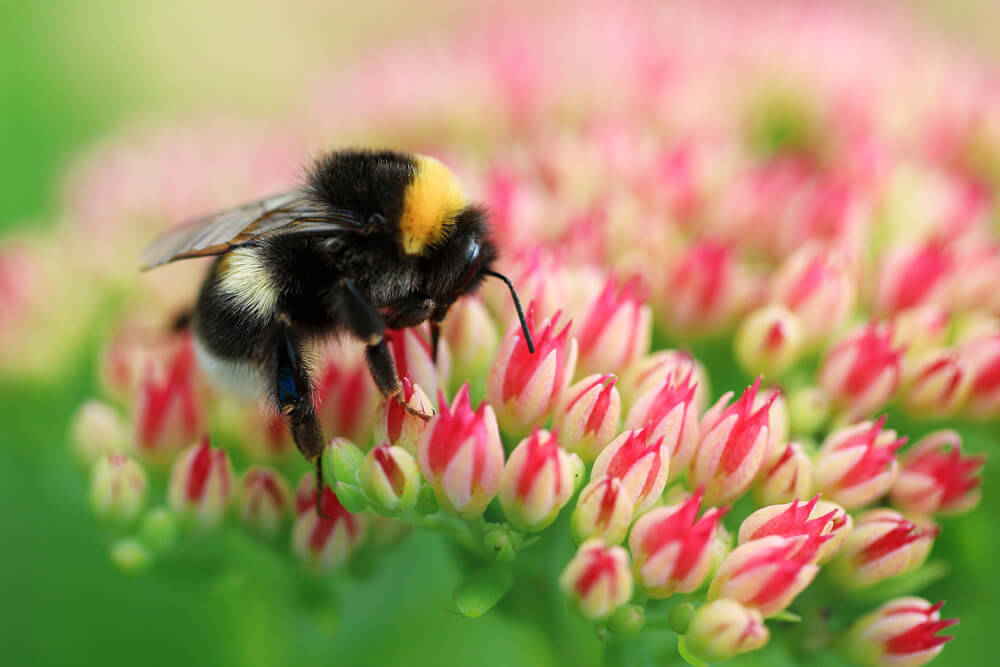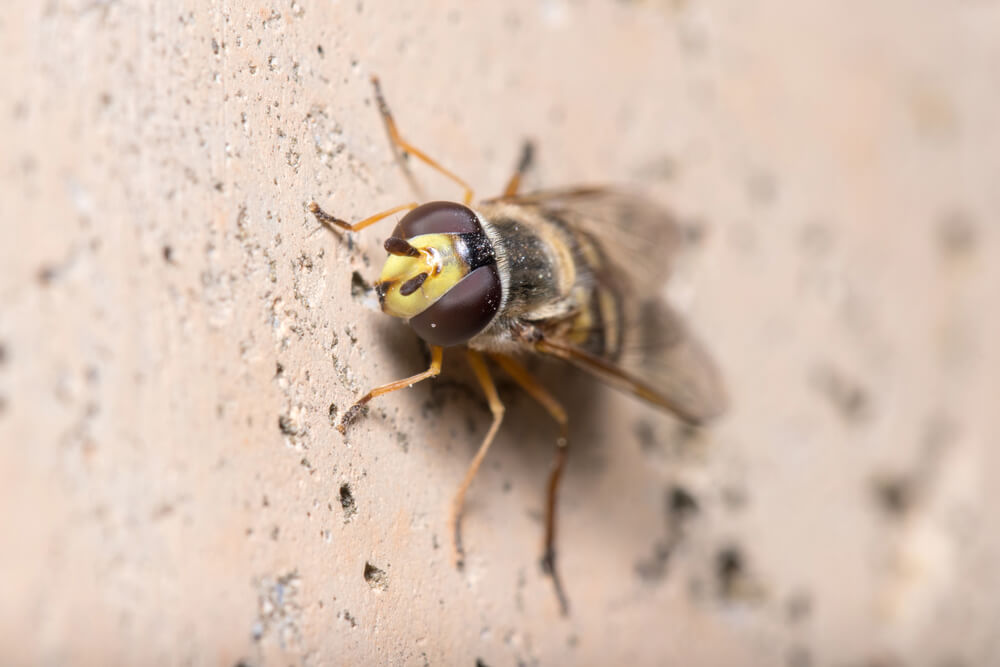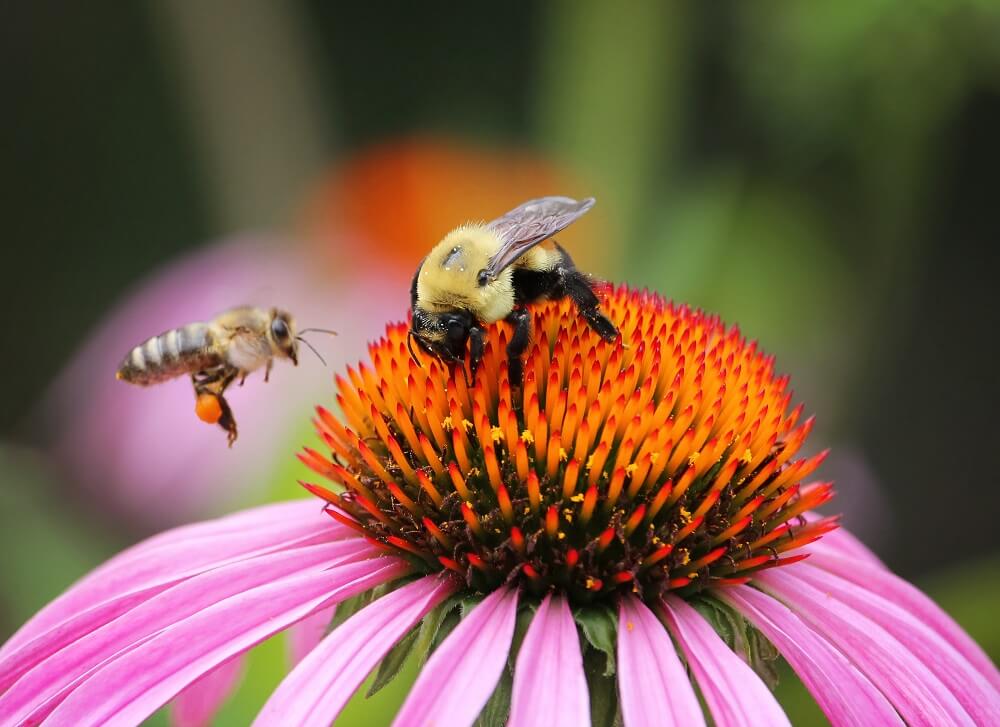Table of Contents:
What’s the Difference Between Hornets, Bees, and Wasps?
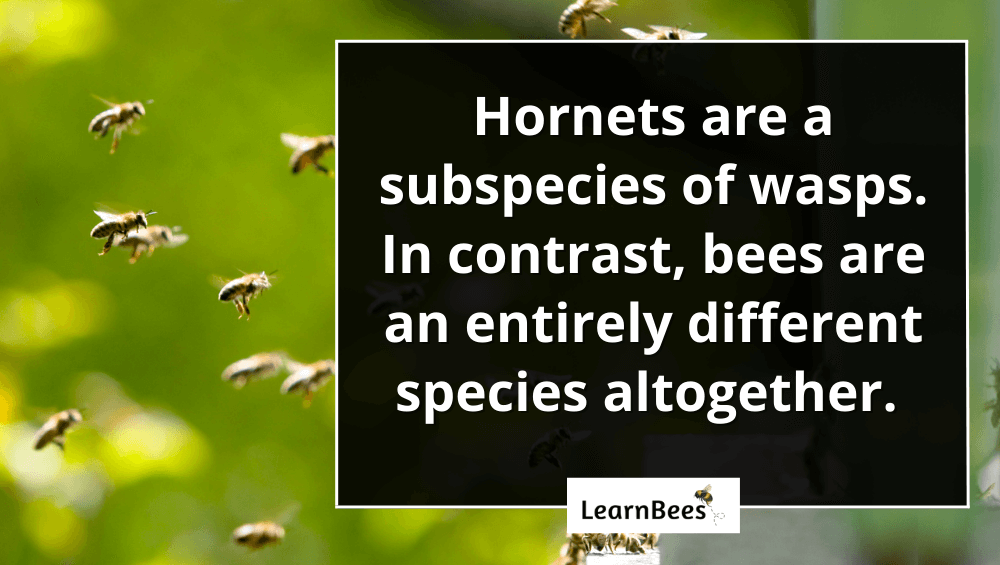
Let’s start with the obvious:
Hornets, bees, and wasps are all flying insects that can sting.
But you might be surprised to learn that hornets are actually a subspecies of wasps. So all hornets fall under the wasp umbrella, but not all wasps are hornets.
As for bees?
They’re closely related to wasps, but they’re an entirely different group of insects.
And it’s worth mentioning:
There are thousands of different species of bees and wasps. For example, common bee species are bumblebees, honeybees, and carpenter bees. Common wasps species are yellowjackets, paper wasps, and mud daubers.
So what are the differences and similarities between them?
Let’s discuss a few.
Wasps vs. Hornets vs. Bees – Appearance
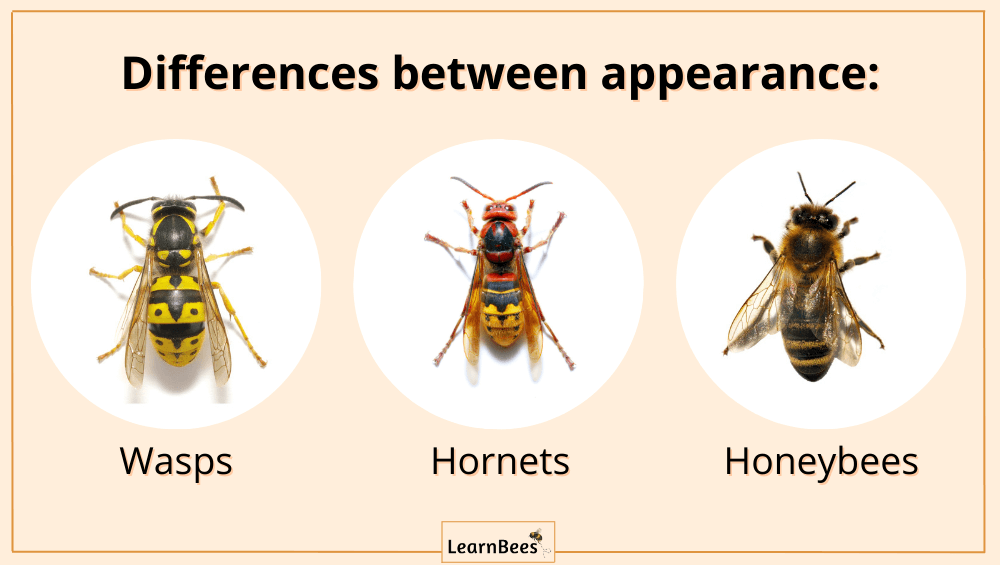
Individual bee, hornet, and wasps species may have different characteristics, but there are general ways to tell them apart:
- Shape – Most bees, especially bumble bees, have bigger abdomens than hornets and wasps. Wasps and hornets are typically longer and thinner.
- Color – The coloring between bees, hornets, and wasps can be similar depending on the species. For example, both honeybees and yellowjackets have yellow stripes. However, yellow jackets typically have a more vibrant yellow color.
- Texture – If you look closely, you’ll notice that many species of bees are fuzzy with hair. Wasps and hornets, on the other hand, are typically smooth and hairless.
Wasps vs. Hornets vs. Bees – Nesting
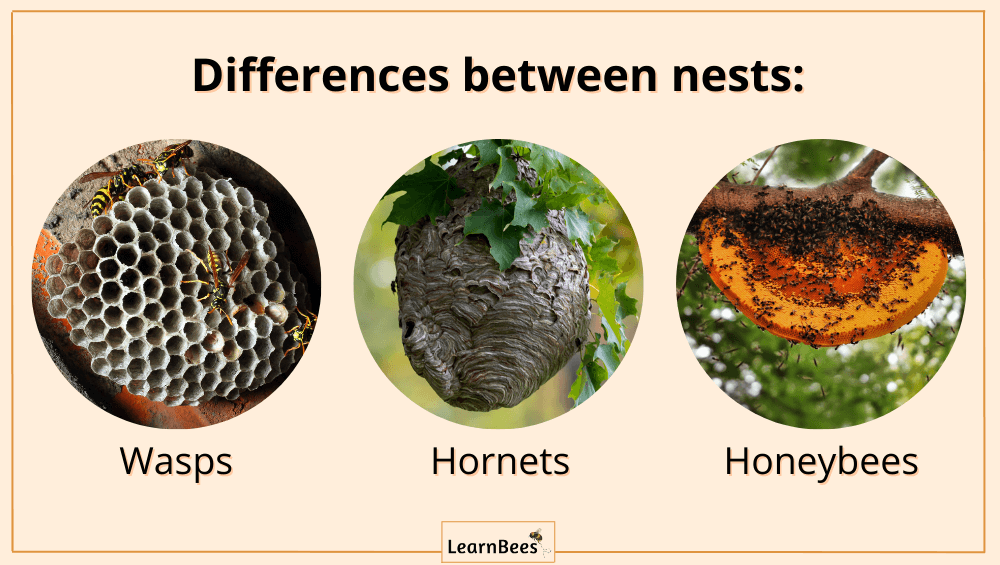
Understanding where hornets, bees, and wasps nest is beneficial to identifying them. It can also prevent you from accidentally disturbing a colony.
Bee Nests
Most bees nest underground in empty rodent holes or inside piles of vegetation.
However, some types of bees nest above ground. Honeybees and carpenter bees are the two main examples. Honeybees nest inside empty tree cavities or under the edges of objects.
Carpenter bees nest inside wood such as cedar, pine, and cypress. Carpenter bees use their strong mandibles (jaws) to drill inside the wood. You might find these holes inside your deck or around the exterior of your home.
Hornet Nests
Hornets typically nest on the branches of trees or under the eaves of houses. Their nests can become large, like the size of a basketball. They usually have one entry hole for the hornets to enter and exit.
Wasp Nests
Like bees, the nesting habits of wasps differ depending on the species.
For example, yellow jackets are a common type of wasp that nests underground in holes or crevices.
On the other hand, you might notice that paper wasps and mud daubers frequently build nests under porches, garages, and other shelters around your home.
Wasps vs. Hornets vs. Bees – Temperament
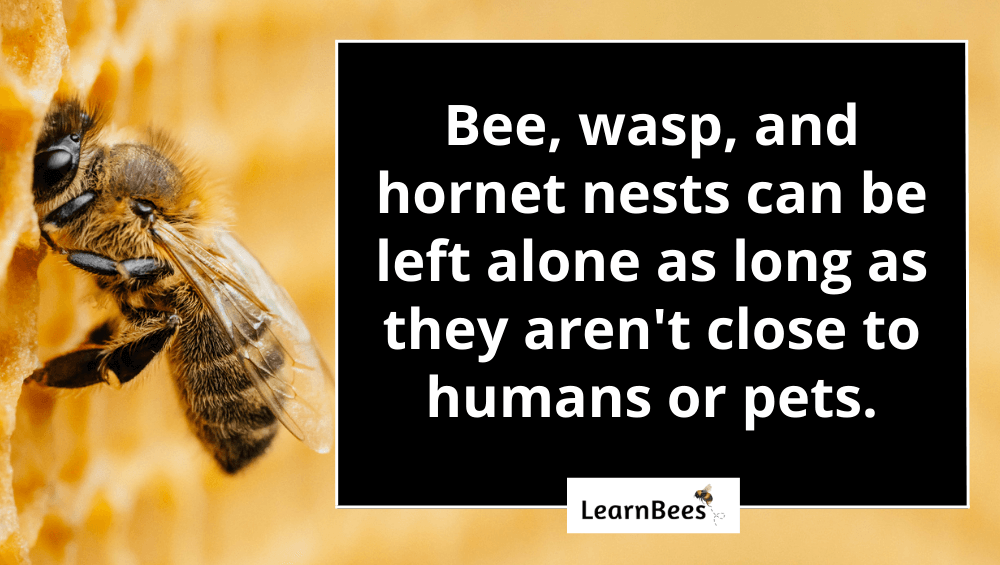
Some species of bees, hornets, and wasps are very temperamental. While others are more gentle and passive-natured.
The most common bees we encounter in North America are honeybees and bumblebees. Both of these bee species are mild-natured and gentle when buzzing around flowers. They typically only become defensive if you get too close to their hives.
And despite popular belief?
Wasps and hornets are also usually fine when left alone.
Sure, wasps and hornets are known to be slightly more aggressive than bees. But, you’ll typically be fine as long as you give them plenty of space.
With that said, remember that some pets will chase bees, wasps, or hornets. So be cautious when it comes to your pets and these insects.
Wasps vs. Hornets vs. Bees – Sting
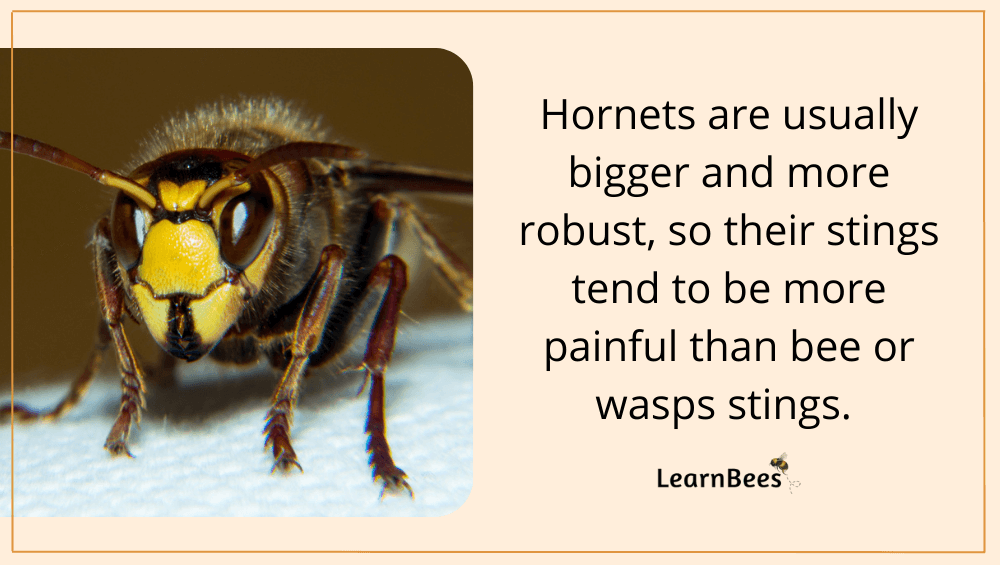
In most cases, hornet stings are slightly more painful than bee or wasps stings. This is because hornets are usually larger and more robust than bees and wasps.
But hornets, bees, and wasps all share one thing in common:
Only the females can sting.
A stinger is a modified egg-laying device, so only the female bees, hornets, or wasps have them. Males do not.
However, that doesn’t stop the males from putting on a good show to scare off intruders. They may buzz quickly around predators, but they can’t actually sting them.
For example, male carpenter bees do a technique called ‘dive bombing’ where they fly aggressively at predators to ward them off.
Despite this, male carpenter bees are all talk, no action.
And here’s another interesting fact that might surprise you:
Honeybees can only sting humans once before dying.
In contrast, hornets, wasps, and even other species of bees can sting multiple times without dying. This is because a honeybee’s stinger gets stuck in human skin once they try to fly away.
As a result?
The stinger gets ripped out during their escape, pulling out other vital organs along with it.
But wasps, hornets, and other bee species have smooth stingers that don’t get lodged inside our skin. As such, they can sting as many times as necessary.
What Do Hornets, Bees, and Wasps Eat?
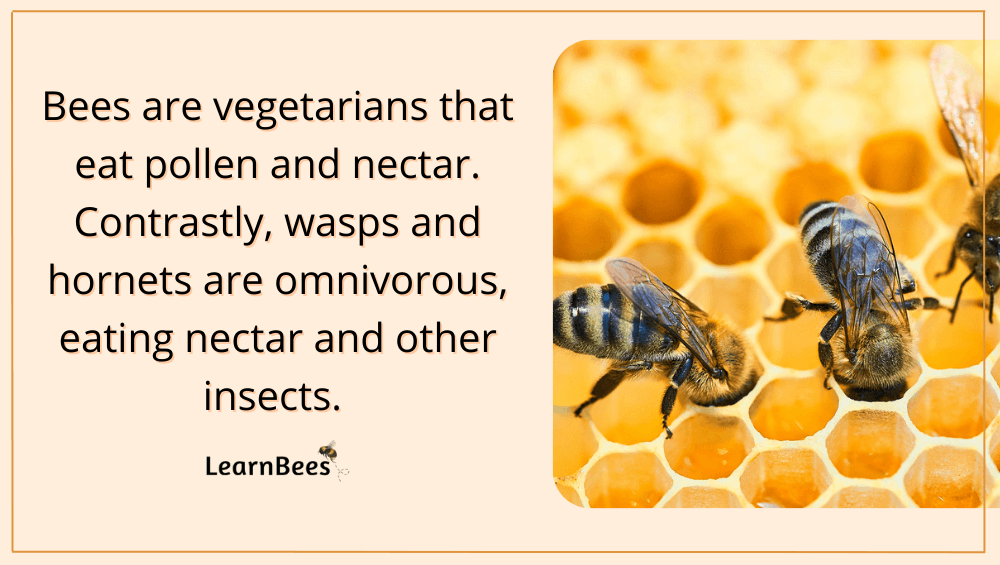
Bees collect nectar and pollen from flowers to bring back to their hives. They use nectar as their main carbohydrate source and pollen as their main protein source.
So essentially, bees are vegetarians.
On the other hand, wasps and hornets are omnivorous.
They eat nectar and other insects. Wasps use their sting to paralyze other insects before bringing them back to their hive to feed their growing larvae.
Additionally, wasps and hornets have been known to attack and kill bees. This is especially true during times of nectar dearth, such as when the flowers are wilting due to hot summer temperatures with little rainfall.
FAQs on Wasps vs. Hornets vs. Bees
- Is a hornet worse than a bee?
- Do hornets eat bees?
- Are hornets more aggressive than bees?
- Which is worse: a wasp or hornet?
- Do hornets sting for no reason?
- Do hornets hate bees?
- Do hornets and wasps pollinate like bees?
- What’s the difference between a wasp vs. bee sting?
- What’s the difference between a hornet vs. bee sting?
Is a hornet worse than a bee?
No, hornets are not worse than bees. They may be slightly more aggressive with a more painful sting, but they’re still essential insects for the ecosystem.
In fact, they are quite similar in many ways. Both insects are capable of stinging, and both are essential pollinators. A key difference is that hornets are omnivores, while bees are vegetarians.
They also have subtle differences, such as nesting habits and the size of their hives.
The hornet is considerably larger than most bees, with a wider and longer stinger. In addition, because their stinger is not barbed, hornets can sting multiple times.
Honeybees can only sting humans once before they die because their stinger gets stuck in the victim’s skin and rips out their intestines when they try to fly away.
With that said, other bee species have smooth stingers that they can use to sting multiple times. For example, bumblebees, carpenter bees, and mason bees can all sting as many times as needed for defense.
—> Go back to the FAQs on wasps vs. hornets vs. bees
More to Explore:
- Do Yellowjackets Make Honey or Honeycomb?
- Wasps vs. Honeybees: Are They Different?
- Do Wasps Make Honey?
Do hornets eat bees?
Hornets do eat bees, but they are not the only predators of bees. Birds, skunks, and spiders include bees as a regular part of their diet.
However, a beehive has the means to defend themselves against hornets or wasps.
The bees are not defenseless when a single hornet invades a bee hive. Hundreds of bees will “ball” the hornet and kill it.
However, if several hornets attack the colony at once, it can be destroyed. Adult honey bees, larvae, and pupae are all vulnerable to these attacks. In large numbers, hornets can kill off an entire bee colony in a matter of hours.
The most common time for bees to face problems from wasps is during the late summer. The hornet colony reaches its maximum size during this period.
Hornets also capture bees in the air or while they’re foraging on flowers or other food sources.
—> Go back to the FAQs on wasps vs. hornets vs. bees
More to Explore:
Are hornets more aggressive than bees?
When their nest sites are threatened, hornets become extremely aggressive.
However, there is a species of honeybees called Africanized honeybees. These bees are more aggressive than other honeybees and will attack in response to any perceived threat.
Africanized honeybees are very territorial and will chase an intruder for up to a quarter of a mile. They have also been known to kill humans and animals.
So while hornets may generally be more aggressive than other bees, at least one species of bee is more aggressive than hornets.
—> Go back to the FAQs on wasps vs. hornets vs. bees
More to Explore:
Which is worse: a wasp or hornet?
Neither.
Hornets may be able to deliver a slightly more painful sting, but both wasps and hornets are beneficial for the ecosystem.
But I get it.
When most people think about wasps or hornets, they first think about being stung. Wasps do sting and can cause discomfort.
These little creatures can drive humans batty—and not just because they’re irritating. Some wasps or hornets build their nests in high-traffic areas.
If this has been your experience with wasps, you’re probably wondering if they’re valuable to our ecosystem at all.
So now the question becomes:
Are wasps and hornets beneficial?
Yes. For starters, hornets and wasps eat other insects, helping to keep pest insect populations in check. For instance, paper wasps bring caterpillars and leaf beetle larvae back to their nests to feed their young.
Also, yellowjacket wasps feed their young by scrapping dead insects, which prevents insect corpses from piling up, much like a housekeeping service.
So ultimately, neither hornets nor wasps are bad. They serve the role that nature intended for them.
—> Go back to the FAQs on wasps vs. hornets vs. bees
More to Explore:
Do hornets sting for no reason?
Not necessarily.
Keep in mind:
There are always two sides to every story.
The majority of hornet stings happen when hornets are trying to defend the colony. Most parents would protect their own families in the same way when necessary.
But most of the time, hornets move passively, only attacking when they feel threatened.
Hornets are the most aggressive when they perceive you as dangerous to their nest. If you approach their nest, you’ve given them a cause to attack.
You should try to maintain a distance of 10 feet or more from a hornet’s nest to avoid getting stung.
—> Go back to the FAQs on wasps vs. hornets vs. bees
More to Explore:
- How Do You Get Rid of a Yellowjacket Ground Nest?
- How Long Do Bumble Bees Live?
- Honeybees vs. Bumblebees: How Do They Compare?
Do hornets hate bees?
It’s not that hornets hate bees.
Hornets are predators of bees and will hunt them for food. It’s the circle of life.
The hornet is looking for a meal, and the bee is its prey. However, a healthy beehive can fight off hornets.
Bees have a few defenses against hornets. The bees are not defenseless when a single hornet invades a bee hive. The bees will swarm the hornet and kill it.
However, if several hornets attack the colony at once, it can be difficult for the bees to defend themselves.
—> Go back to the FAQs on wasps vs. hornets vs. bees
More to Explore:
Do hornets pollinate like bees? Do wasps pollinate like bees?
Hornets, like honeybees, contribute to the reproduction of fruits and flowers. As they fly from plant to plant, hornets also pollinate the plants.
So in a nutshell:
Wasps and hornets are beneficial pollinators. This is one benefit that they bring to any garden. They also clear out crop-eating insects by feeding them to their young.
That said, hornets and wasps aren’t as successful at pollinating as bumblebees or mason bees.
—> Go back to the FAQs on wasps vs. hornets vs. bees
More to Explore:
What’s the difference between a wasp vs. bee sting?
It depends on the wasp or bee species.
Generally speaking, many people consider wasp stings to be slightly more painful than bee stings.
But as mentioned, both bees and wasps generally prefer to be left alone and will not disturb you if you honor their space.
Additionally, honeybees are a type of bee species that can only sting humans and mammals once. They lose their stinger during the process and die soon after.
On the other hand, wasps can sting humans and animals multiple times because they don’t have barbed stingers that get stuck in the skin.
Also, both male bees and wasps cannot sting because they don’t have stingers. Only females can.
—> Go back to the FAQs on wasps vs. hornets vs. bees
More to Explore:
What’s the difference between a hornet vs. bee sting?
Hornets are typically bigger than bees, and their stings are usually more painful. However, like bees, hornets are mostly only aggressive and will only sting humans if you’re too close to their hive.
And unlike hornets, honeybees are a type of bee species that die after stinging humans. This is because their stingers get stuck in the skin and tear away from their bodies.
Hornets, on the other hand, can sting humans and animals multiple times because they don’t have barbed stingers that get stuck in the skin.
